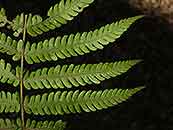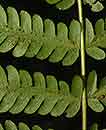Christella hispidula (Decne.) Holttum
Synonyms |
Thelypteris hispidula (Decne.) Reed |
|---|---|
Common name |
|
Description |
Rhizome erect or inclining, c.20 mm in diameter; rhizome scales lanceolate in outline, margin entire or ciliate, up to 6 mm long, dark brown, often thinly pilose. Fronds monomorphic, tufted, arching, not proliferous, herbaceous. Stipe 12-40(-60) cm long, pale brown, thinly set with minute stiff hairs and scaly at base. Lamina deeply 2-pinnatifid, ovate to broadly lanceolate in outline, apex tapering to a point with a pinnatifid terminal segment, basal 2-4 pairs of pinnae slightly reduced and deflexed, 25-60 × 30 cm; pinnae linear-oblong in outline, apex tapering to a point, 8-16 x 1.2-2.2 cm; ultimate lobes narrowly oblong in outline, slightly falcate, apex rounded, basal acroscopic lobe enlarged, margin entire, 4-10 x 2-5 mm, both surfaces with long, white hairs, more so below, particularly along the veins, costae and costules; veins 1 pair meeting some way below the sinus; rhachis set with long pale hairs. Sori round, up to 13 per lobe; indusia coriaceous, thickly set with long white hairs. |
Notes | Christella hispidula resembles C. dentata but the latter has 1 pair of veins meeting below the sinus and a single vein joining in the sinus and a clearly creeping rhizome.
|
Derivation | hispidula: minutely rough with stiff hairs (hispidulous) |
Habitat | Evergreen forest floor away from water or along streambanks in forest, always in deep shade. |
Distribution worldwide | Africa, Madagascar, Mauritius, Seychelles, E. tropical Asia and tropical S. America. |
Distribution in Africa |
Angola, Equatorial Guinea (incl. Bioko), Ethiopia, Ghana, Ivory Coast, Kenya, Liberia, Malawi, Mozambique, Nigeria, Rwanda, Sierra Leone, South Africa, Swaziland, Tanzania , Zambia, Zimbabwe. |
Growth form |
Terrestrial. |
Literature |
|



